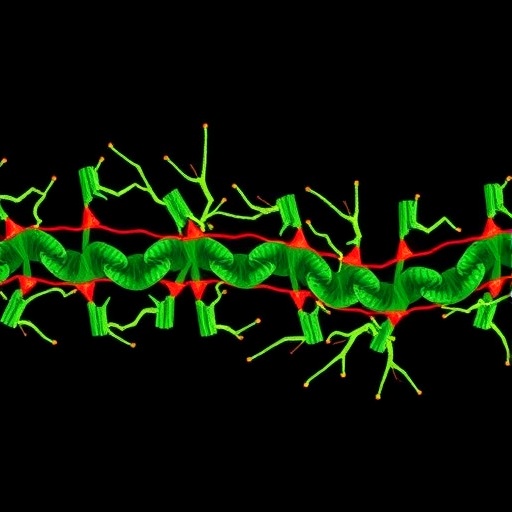In a groundbreaking study that could transform our understanding of plant-pathogen interactions, researchers have delved into the intricate world of Valsa mali, a notorious fungus known for its capacity to inflict substantial damage on a variety of plant species. This research, spearheaded by a team led by experts Meng, X., Dong, Y., and Yin, J., highlights the role of the gene Vmplc1 in regulating the pathogenicity of Valsa mali when exposed to low temperatures. Given that climate change has led to unpredictable weather patterns affecting agricultural productivity, understanding the mechanisms of pathogenicity in pathogens like Valsa mali is of paramount importance.
Low temperatures are not just a seasonal challenge for crops but represent a significant biological barrier that affects the life cycle and virulence of various pathogens. Valsa mali, which has adapted to thrive under these suboptimal conditions, showcases an evolutionary tone that merits thorough exploration. In their research, the authors employed transcriptome sequencing—a robust technique that allows for the comprehensive analysis of gene expression profiles—to uncover the molecular pathways that govern the interactions between Valsa mali and host plants.
The authors level their focus on Vmplc1, a gene that appears to play a crucial role in the pathogen’s ability to adapt and remain virulent under conditions that would otherwise hamper its growth. Previous studies have hinted at the multifaceted nature of pathogenicity, suggesting that a myriad of factors including environmental stressors, genetic predisposition of the pathogen, and host plant defenses are all interlinked in a complex dance of survival and virulence. It’s within this context that Vmplc1 emerges as a promising candidate for further investigation.
One of the most striking findings of the study is the identification of specific pathways activated during cold stress exposure. The transcriptome analysis revealed a significant upregulation of Vmplc1, suggesting its pivotal role in the fungus’s ability to not only survive but flourish even in less-than-ideal temperatures. Such insights into the genetic and molecular workings of Valsa mali could pave the way for innovative strategies in plant disease management. Understanding these mechanisms greatly enhances the potential for breeding or engineering crops with improved resistance to this pathogen.
Moreover, the study also opens the door to exploring broader implications. By dissecting the interactions between Valsa mali and its host under varying climatic conditions, researchers can begin to piece together how other pathogens might behave under the same environmental stresses. This is particularly crucial in our current era where climate change significantly alters the agricultural landscape, creating a fertile ground for the proliferation of pathogens.
The scientific community has recognized the importance of such detailed studies that integrate genetic research with environmental biology. As the incidence of plant diseases caused by fungi rises globally, the insights derived from the work of Meng et al. offer essential value not just for academic research, but for agriculture at large. Findings such as these assist policymakers and farmers in devising strategic responses to potential outbreaks, which could ultimately protect food security.
Significantly, the methods employed in this study may serve as a model for future research endeavors targeting other pathogens. The transcriptome sequencing approach could potentially be adapted for use with a variety of fungi, providing a roadmap for examining genetic responses to environmental stresses. This adaptability underscores the importance of the findings that stem from the study of Valsa mali.
As researchers probe deeper into the world of plant-pathogen interactions, the potential for discovering new targets for biocontrol strategies is heightened. The identification of Vmplc1 as a key player raises the possibility of genetic manipulation to render the fungus less virulent or planting resistant crop varieties that can withstand invasion. These strategies hold incredible promise as global agricultural practices face unprecedented challenges.
Critical to the implications of the study, one must also consider the economic ramifications tied to plant diseases. Fungal pathogens, particularly in crops, can wreak havoc on yields, leading to extensive financial losses. By equipping agronomists and farmers with knowledge about how to tackle pathogens like Valsa mali, there is potential not only to bolster crop resilience but also to stabilize markets and ensure continuity in food supply chains.
In summation, the research led by Meng, X., Dong, Y., and Yin, J. stands as a significant contribution to our understanding of fungal pathogenicity, particularly Valsa mali under low-temperature conditions. Their investigation of the gene Vmplc1 acts as a gateway into deeper inquiries regarding pathogen survival and adaptability. As future research builds upon these foundational findings, the agricultural sector can be hopeful for enhanced strategies that ensure crop health and food security amid evolving environmental challenges.
The journey into understanding Valsa mali’s pathogenicity through the lens of Vmplc1 opens up pathways for innovation and application that can resonate throughout the scientific and agricultural communities alike. As we advance, the knowledge garnered from such studies will undeniably play a vital role in shaping the future of sustainable agriculture.
Subject of Research: Pathogenicity of Valsa mali under low-temperature conditions and the role of gene Vmplc1.
Article Title: Transcriptome sequencing reveals Vmplc1 involved in regulating the pathogenicity of Valsa Mali under low temperature induction.
Article References:
Meng, X., Dong, Y., Yin, J. et al. Transcriptome sequencing reveals Vmplc1 involved in regulating the pathogenicity of Valsa Mali under low temperature induction.
BMC Genomics (2025). https://doi.org/10.1186/s12864-025-12303-4
Image Credits: AI Generated
DOI:
Keywords: Valsa mali, pathogenicity, Vmplc1, transcriptome sequencing, low temperature, fungal pathogens, plant disease management, agricultural sustainability, climate change.
Tags: agricultural productivity challengesclimate change and agriculturecold temperature effects on pathogensfungal adaptation to coldgene expression analysis in pathogensmolecular pathways in plant diseasesplant-pathogen interactionstranscriptome sequencing in fungiunderstanding fungal virulence factorsValsa mali and crop damageValsa mali pathogenicityVmplc1 gene regulation





